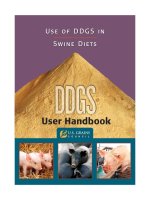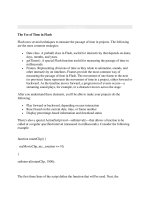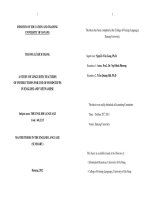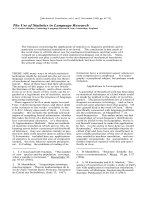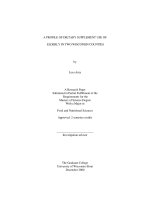Use of DDGS in Swine Diets
Bạn đang xem bản rút gọn của tài liệu. Xem và tải ngay bản đầy đủ của tài liệu tại đây (346.28 KB, 15 trang )
User Handbook
Use of DDGS in
Swine Diets
Use of DDGS in
Swine Diets
05 - Use of DDGS in Swine Diets
1
Use of U.S. DDGS in Swine Diets
Historical Use of DDGS in Swine Diets
Historically, limited amounts (less than 3% of total production) of distiller’s co-products were
used in swine diets until about the year 2000. During the past 60 years, research has been
conducted to evaluate three types of distiller’s co-products in swine diets – distiller’s dried
solubles (DDS), distiller’s dried grains (DDG) and distiller’s dried grains with solubles (DDGS).
In the 1940’s and 1950’s, most of the research on feeding distiller’s co-products to swine focused
on evaluating DDS. Performance trials were conducted to measure growth rate and feed
conversion of pigs when DDS was added to starter (Krider et al., 1944; Catron et al., 1954) and
grower-finisher diets (Fairbanks et al., 1944; Beeson et al, 1959). Several studies were also
conducted to determine if DDS could replace common protein (Fairbanks et al., 1945; Hanson,
1948; Winford et al., 1951) and vitamin (Krider and Terrill, 1949) supplements in corn-based
diets during various phases of production.
Beginning in the late 1950’s, researchers continued to evaluate growth performance of pigs fed
distiller’s co-products (Livingstone and Livingston, 1966; Combs and Wallace, 1969; and
Combs and Wallace, 1970), but interest in identifying “unidentified growth factor(s)” in
distiller’s co-products and their effects on swine growth performance became a research focus
(Beeson et al., 1959; Couch et al., 1960; Conrad, 1961; Wallace and Combs, 1968).
In the 1970’s and 1980’s, construction of large scale ethanol plants occurred and researchers
began to focus on evaluating DDGS. A series of titration experiments were conducted to
determine maximal inclusion rates of DDGS that could be added to starter (Wahlstrom and
Libal, 1980; Orr et al., 1981; Cromwell et al., 1985) and grower-finisher diets (Wahlstrom et al.,
1970; Smelski and Stothers, 1972; Cromwell et al., 1983). Additional studies focused on amino
acid content of DDGS and the effect of lysine supplementation on performance of pigs fed diets
containing DDGS (Wahlstrom and Libal, 1980; Cromwell et al. 1983; Cromwell and Stahly,
1986).
From 1986 until 1998, very little research was conducted to evaluate the use of distiller’s co-
products in swine feeds, even though several new dry-grind fuel ethanol plants were being built.
These relatively new,dry-mill ethanol plants use state-of-the-art engineering designs,
fermentation technologies and drying processes compared to older plants that were built and
operating decades before. Consequently, the nutrient content and digestibility of DDGS
produced by these modern ethanol plants are higher than published in National Research Council
(NRC) in 1998.
Nutritional Value of DDGS for Swine
High quality DDGS has a digestible and metabolizable energy value equal to or greater than
corn. Spiehs et al. (1999) was the first to report that the digestible energy (DE) and metabolizable
energy (ME) values were similar to energy values for corn (3.49 Mcal/kg and 3.37 Mcal/kg,
respectively). Fu et al. (2004) reported that the ME and net energy (NE) values for DDGS were
3.25 Mcal/kg and 2.61 Mcal/kg, respectively, whereas Hastad et al. (2004) reported much higher
values for DE, ME and NE (3.87 Mcal/kg, 3.60 Mcal/kg, and 2.61 Mcal/kg, respectively). Stein
05 - Use of DDGS in Swine Diets
2
et al. (2006) confirmed that the DE and ME value of DDGS for swine is equal to, or greater than
corn (3,639 kcal DE/kg and 3,378 kcal ME/kg).
Like the low protein quality (low lysine and poor amino acid balance) of corn, DDGS is also
low in lysine relative to its crude protein content. Threonine is the second limiting amino acid
after lysine, and should be monitored during diet formulation when using more than 10% DDGS
in swine diets. Amino acid digestibility can also vary among DDGS sources. Stein et al. (2006)
showed that the range in true lysine digestibility coefficients for swine ranges from 43.9-63.0%.
Fastinger and Mahan (2006) reported a similar range in standardized ileal lysine digestibility
values (38.2-61.5%) when five sources of DDGS were evaluated. Lightness and yellowness of
color of DDGS appear to be reasonable predictors of digestible lysine content among DDGS
sources for swine (Pederson et al., 2005). In order to ensure excellent pig performance when
adding DDGS to swine diets, only light colored sources should be used and diets should be
formulated on a digestible amino acid basis if more than 10% DDGS is included in the diet.
DDGS is an excellent source of available phosphorus for swine. Whitney et al. (2001) showed
that relative phosphorus availability in DDGS was 90%, using dicalcium phosphate as the
inorganic phosphorus reference source.
Use of DDGS in starter diets
Whitney and Shurson (2004) conducted two experiments to determine the effects of increasing
dietary levels (0-25%) of DDGS on growth performance of early-weaned pigs. A total of 96
crossbred pigs (BW = 6.18 ± 0.14 kg) were blocked by gender and ancestry, and pigs within each
block were randomly assigned to one of six dietary treatments (4 pigs/pen, 4 pens/treatment) in
each of two growth performance experiments. Dietary treatments consisted of providing 0, 5, 10,
15, 20, or 25% DDGS during Phases 2 and 3 of a 3-phase nursery feeding program. Pigs in
Experiment 1 were slightly older (19.0 vs. 16.9 days of age) and heavier (7.10 vs. 5.26 kg) at the
beginning of the experiment compared to pigs in Experiment 2. All pigs were provided a
commercial pelleted diet for the first 4 days post-weaning, and were then switched to their
respective experimental Phase 2 diets (fed for a subsequent 14 days), followed by Phase 3
experimental diets (fed for an additional 21 days). Experimental diets were formulated to contain
equivalent apparent ileal digestible lysine (1.35 and 1.15%) and methionine + cystine (0.80 and
0.65%), ME (3340 and 3390 kcal/kg), calcium (0.95 and 0.80%) and total phosphorus (0.80 and
0.70%) within Phases 2 and 3, respectively.
Overall growth rate, ending body weight, and feed conversion of pigs were similar among
dietary treatments regardless of dietary DDGS level fed for both experiments. In Experiment 1,
feed intake was unaffected by dietary treatment. In Experiment 2, however, increasing dietary
DDGS level linearly decreased feed intake during Phase 2, and tended to decrease voluntary feed
intake over the length of the experiment. These results suggest that high quality DDGS can be
included in Phase 3 diets for nursery pigs at dietary levels up to 25%, without negatively
affecting growth performance after a two-week acclimation period. Satisfactory growth
performance can also be achieved when adding up to 25% DDGS in Phase 2 diets for pigs
weighing at least 7 kg in body weight. Including these high levels immediately post-weaning,
however, may negatively influence feed intake, resulting in poorer initial growth performance.
More recently, Gaines et al. (2006) conducted two trials to evaluate the effect of dietary levels
of DDGS and choice white grease on growth performance in the late nursery phase of growth
(more than 11 kg BW). The first trial was conducted to evaluate dietary DDGS inclusion rates of
05 - Use of DDGS in Swine Diets
3
0, 15 and 30% without supplemental fat. The second trial used the same dietary levels of DDGS
as in the first trial, but also evaluated the effect of adding 0 or 15% choice white grease to the
diet on growth performance. There was no effect of dietary DDGS inclusion level or fat source
on average daily gain. In the second trial, both feeding diets containing DDGS and the addition
of 5% choice white grease improved the gain:feed ratio, which was attributed to lower feed
intake.
Use of DDGS in Grower-Finisher Diets
Whitney et al. (2006c) conducted a study to determine the effects of feeding diets containing 0,
10, 20 or 30% DDGS on growth performance and carcass characteristics of grower-finisher pigs.
They used a total of 240 crossbred pigs with an initial body weight of about 28.6 kg, and
assigned them to one of four diet sequences in a five-phase grower-finisher feeding program.
Corn-soybean meal diets were formulated on total lysine basis, and also contained up to 4%
soybean oil as a supplemental fat source. Soybean oil was chosen as the supplemental fat source
for this study because we did not have the ability to use animal fats at the location where this
study was conducted. Therefore, these experimental diets contained unusually high levels of
unsaturated fatty acids compared what is currently being fed to grower-finisher pigs in the U.S.
pork industry.
As shown in Table 1, pigs fed the diets containing 10% DDGS grew at the same rate,
consumed the same amount of feed and had the same feed conversion as pigs fed the control
corn-soybean meal diets. Feeding diets containing 20% DDGS resulted in reduced growth rate
but feed conversion was not significantly affected. However, feeding diets containing 30%
DDGS reduced growth rate and feed conversion compared to pigs fed the corn-soybean meal
control diets or the diets containing 10% DDGS. This reduction in performance at higher DDGS
inclusion rates was likely due to formulating diets on a total amino acid basis and not accounting
for the digestibility of amino acids in DDGS, which likely resulted in not meeting the pigs amino
acid requirements at the 20 and 30% dietary inclusion rates for DDGS.
Table 1: Effect of Dietary DDGS Level on Overall Growth
Performance of Grower-Finisher Pigs.
0% DDGS 10% DDGS 20% DDGS 30% DDGS
Average Daily Gain
(ADG), kg
0.86
a
0.86
a
0.83
bc
0.81
bd
Average Daily Feed
Intake (ADFI), kg
2.38 2.37 2.31 2.35
Feed/Gain (F/G)
2.76
a
2.76
a
2.80
a
2.92
b
Final Wt., kg
117
a
117
a
114
b
112
b
a, b
Means within row with unlike superscripts are different (P < .05).
c, d
Means within row with unlike superscripts are different (P < .10).
At the end of the feeding portion of this study, pigs were slaughtered to obtain carcass (Table
2), muscle (Table 3) and fat (Table 4) quality measurements. Carcass weight and dressing
percentage of pigs fed the 0 and 10% DDGS diets were the same and greater than those from
pigs fed the 20 and 30% DDGS diets. The lighter carcass weights of pigs fed the 20% and 30%
DDGS diets were a result of reduced growth rate and lighter live weights compared to pigs fed
the control (0%) and 10% DDGS diets. However, there was no difference in backfat thickness or
05 - Use of DDGS in Swine Diets
4
percentage of carcass lean among the different DDGS feeding levels. Pigs fed the 0% DDGS
diets had greater loin depths compared to pigs fed the 30% DDGS diets, with intermediate loin
depths from pigs fed either 10 or 20% DDGS. The differences in loin depth were influenced by
the differences in slaughter weight of pigs among the four dietary treatments. These results
indicate that, although growth performance was negatively affected by feeding diets containing
20 or 30% DDGS, carcass composition was largely unaffected as indicated by the similar fat
depths and percent carcass lean across dietary treatments.
Furthermore, none of the muscle quality measurements except 11-day purge loss were affected
by dietary DDGS level (Table 3). It is unclear why muscle from pigs fed the 20% DDGS had a
higher 11-day purge loss compared to muscle from pigs fed the control diet, but 11-day purge
loss was not different between the 0, 10 and 30% DDGS treatments. These data indicate adding
DDGS at levels up to 30% in swine finishing diets did not have meaningful effects on pork
muscle quality.
Iodine number increased linearly, and thus, belly fat became more unsaturated, as the dietary
concentration of DDGS increased (Table 4). Researchers have clearly established that feeding
diets containing an unsaturated fat source can alter the degree of saturation in pork fat. Lea et al.
(1970) indicated that adequately firm pork fat has an iodine number below 70. Boyd (1997)
suggested that the iodine value threshold for pork fat in the United States should be set at 74. In
our study, iodine values were greater than 70, but less than 74, for the diets containing 30%
DDGS and about 70 for the pigs fed the 20% DDGS diets. A significant amount of unsaturated
fatty acids was supplied to experimental diets from supplemental soybean oil in addition to the
corn oil present in DDGS in this study. We estimate, based on NRC (1998), that a typical swine
finishing diet without supplemental fat (85% corn, 11% soybean meal) would contain about 3%
unsaturated fatty acids. By comparison, we estimated our phase 5 control diet contained 4.33%
unsaturated fatty acids and the Phase 5 diet with 30% DDGS contained 4.96% unsaturated fatty
acids. We expect that if an animal fat source, which is lower in unsaturated fatty acid
concentration, were added to these diets, or if no supplemental fat was added, the iodine values
of carcass fat from pigs fed high concentrations of DDGS would be lower and the negative
effects of adding high levels of DDGS to the diets on pork fat quality would be less. The effect
of DDGS feeding on iodine number was reflected in the analysis of belly firmness score. Lower
belly firmness scores indicated that bellies from pigs that were fed 30% DDGS were softer than
bellies from pigs fed 0 or 20% DDGS. Softer bellies were most likely a consequence of elevated
concentrations of dietary unsaturated lipids supplied by soybean oil and DDGS.
Table 2: Effects of Dietary DDGS Level on
Carcass Characteristics of Grower-Finisher Pigs.
0% DDGS 10% DDGS 20% DDGS 30% DDGS
Slaughter weight, kg
117 119 113 112
Carcass weight, lbs
85.7
c
86.6
c
81.6
d
80.7
d
Dressing %
73.4
c
72.8
c
72.1
d
71.9
d
Fat depth, mm
21.3 21.8 21.1 20.6
Loin depth, mm
56.5
ac
53.9
b
54.8
c
51.6
d
% Carcass lean
52.6 52.0 52.6 52.5
a, b
Means within row with unlike superscripts are different (P < .05).
c, d
Means within row with unlike superscripts are different (P < .10).
05 - Use of DDGS in Swine Diets
5
Table 3: Muscle Quality Characteristics from
Grower-Finisher Pigs Fed Diets Containing 0, 10, 20, and 30% DDGS.
0% 10% 20% 30%
L*
c
54.3 55.1 55.8 55.5
Color score
d
3.2 3.2 3.1 3.1
Firmness score
e
2.2 2.0 2.1 2.1
Marbling score
f
1.9 1.9 1.7 1.9
Ultimate pH
5.6 5.6 5.6 5.6
11-d purge loss, %
2.1
a
2.4 2.8
b
2.5
24-hr drip loss, %
0.7 0.7 0.7 0.7
Cooking loss, %
18.7 18.5 18.3 18.8
Total moisture loss, %
g
21.4 21.5 21.8 22.1
Warner-Bratzler sheer force, kg
h
3.4 3.4 3.3 3.3
a, b
Means within row with unlike superscripts are different (P < .05).
c
0 = black, 100 = white
d
1 = pale pinkish gray/white; 2 = grayish pink; 3 = reddish pink; 4 = dark reddish pink; 5 = purplish
red; 6 = dark purplish red
e
1 = soft, 2 = firm, 3 = very firm
f
Visual scale approximates % intramuscular fat content (NPPC, 1999)
g
Total moisture loss = 11-d purge loss + 24-h drip loss + cooking loss
h
Measure of tenderness
Table 4: Fat Quality Characteristics of Market Hogs Fed
Corn-Soybean Meal Diets Containing 0, 10, 20 and 30% DDGS.
0%
DDGS
10%
DDGS
20%
DDGS
30%
DDGS
Belly thickness, cm
3.15
a
3.00
ab
2.84
bc
2.71
c
Belly firmness score, degrees
27.3
a
24.4
a
25.1
a
21.3
b
Adjusted belly firmness score,
degrees
25.9
d
23.8
de
25.4
d
22.4
e
Iodine number
66.8
d
68.6
e
70.6
f
72.0
f
a, b, c
Means within row with unlike superscripts are different (P < .10).
d, e, f
Means within row with unlike superscripts are different (P < .05).
Based upon these results, including 10% DDGS in conventional swine grower-finisher diets
has no detrimental effects on pig performance, carcass quality or pork quality. When diets are
formulated on a total amino acid basis, it appears that inclusion rates of 20% or higher result in
depressed growth performance. Including DDGS at concentrations of 20 to 30% of the diet, and
using soybean oil as a supplemental fat source for grower-finisher pigs does not affect muscle
composition or quality, but decreases the saturation of fatty acids, resulting in softer bellies and
may negatively affect further processing traits.
A recent commercial field trial conducted by the University of Minnesota and Land O’
Lakes/Purina Feed was conducted in the summer of 2006 to further evaluate the impact of
feeding conventional corn-soybean meal grower-finisher diets – with or without 10% DDGS –
on pork fat quality. Two cooperating pork producers were selected for this study. Each producer
had typical commercial 1,000 head finishing barns and were located in southern Minnesota. Each
